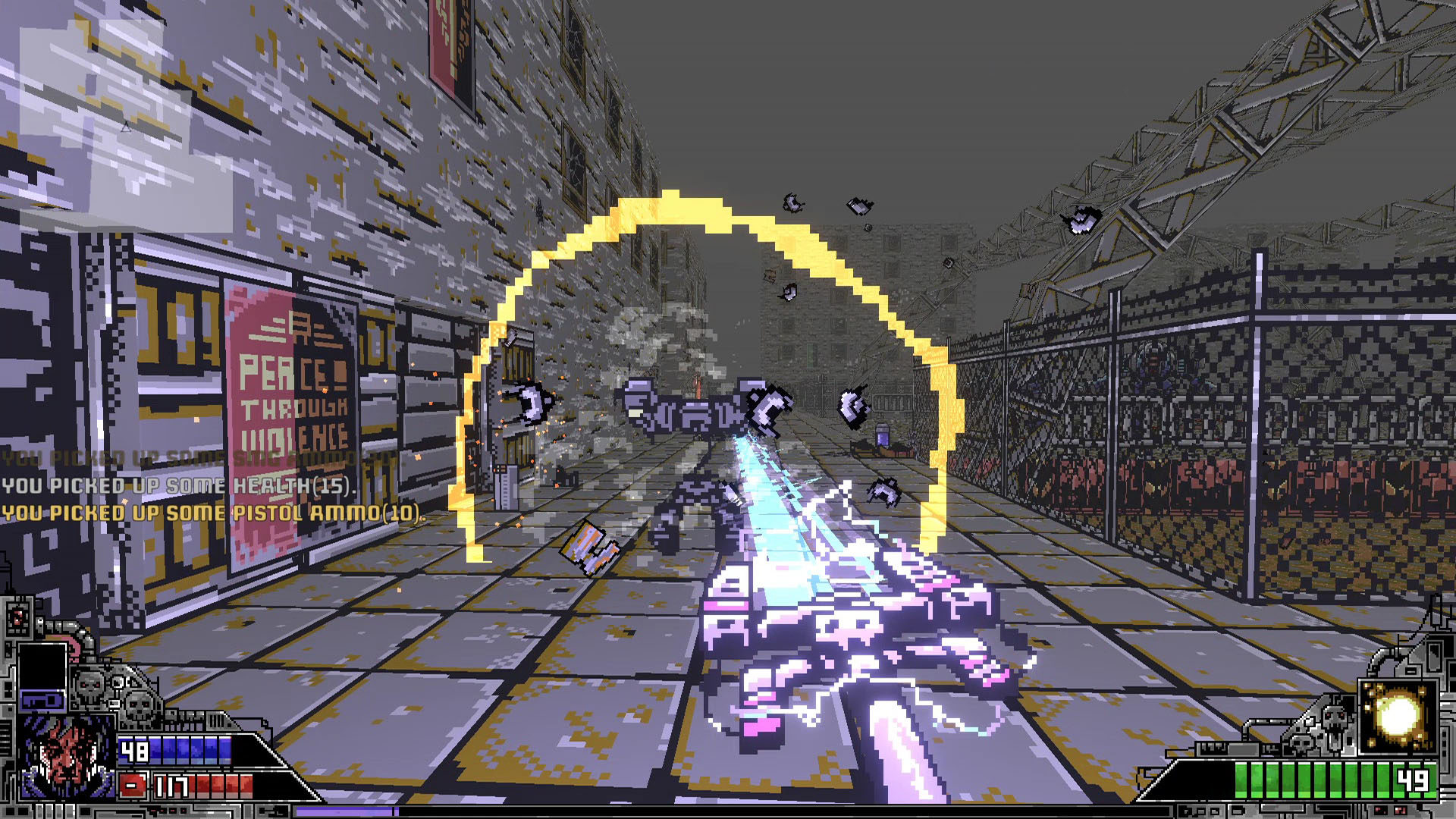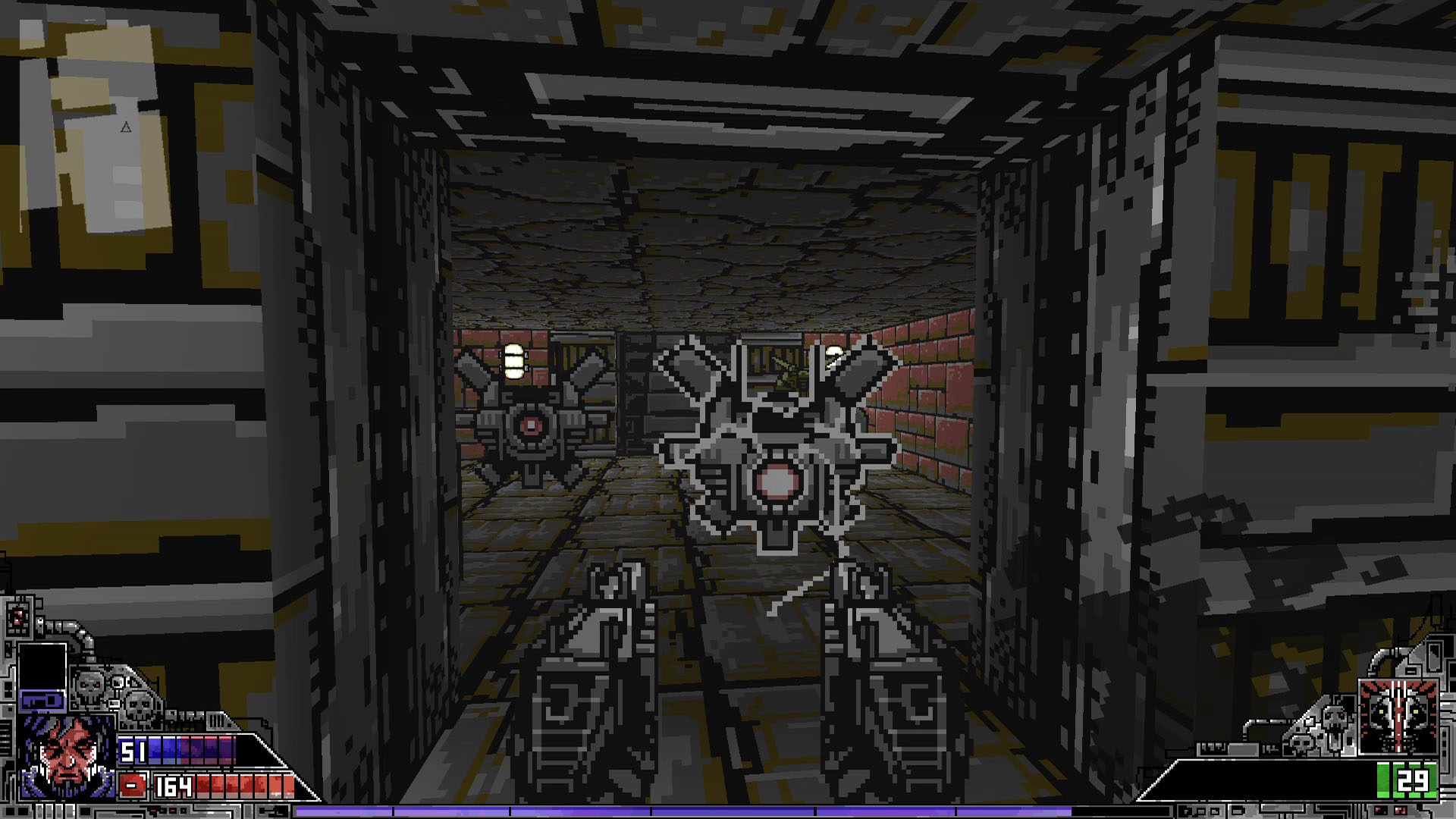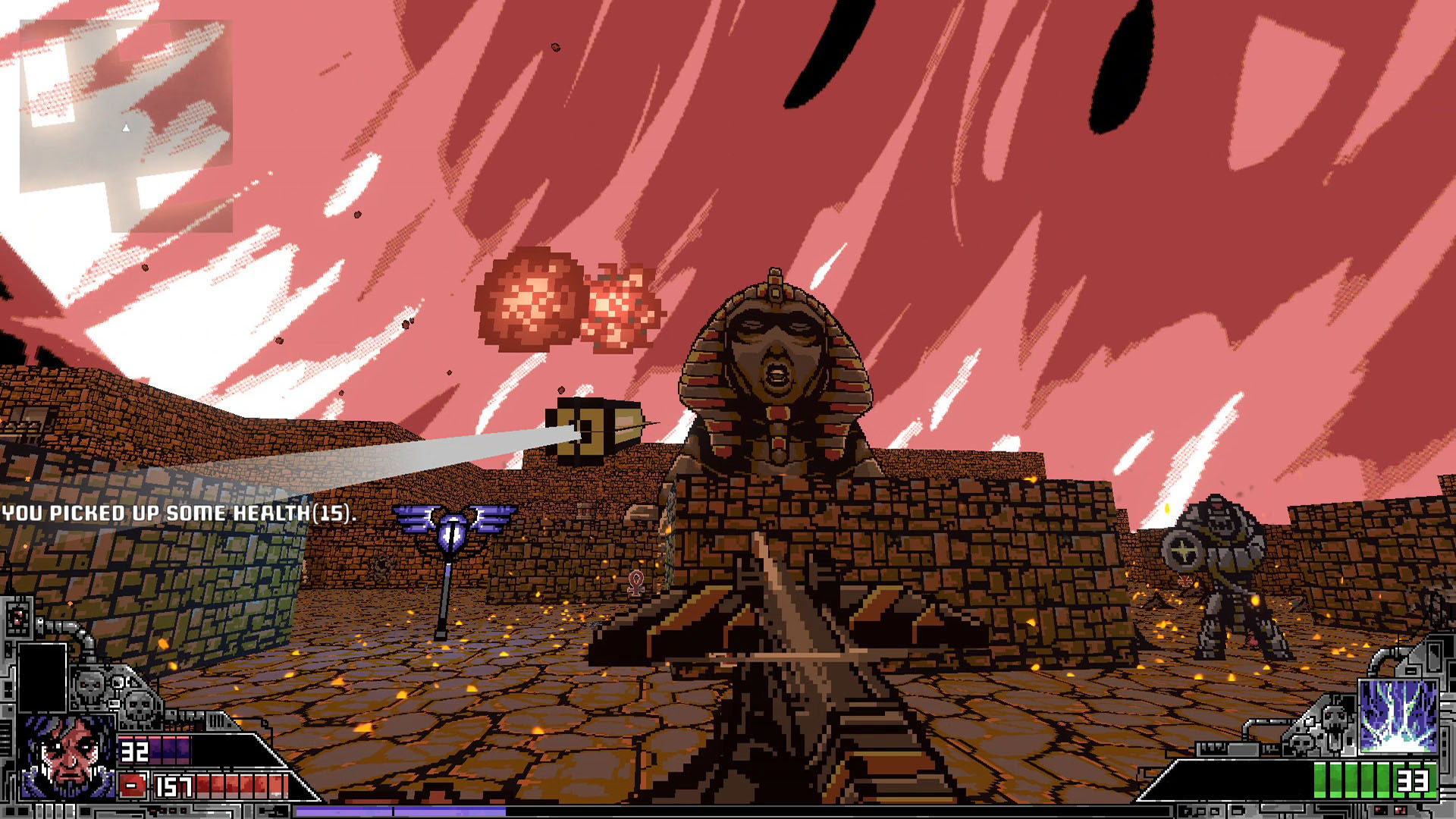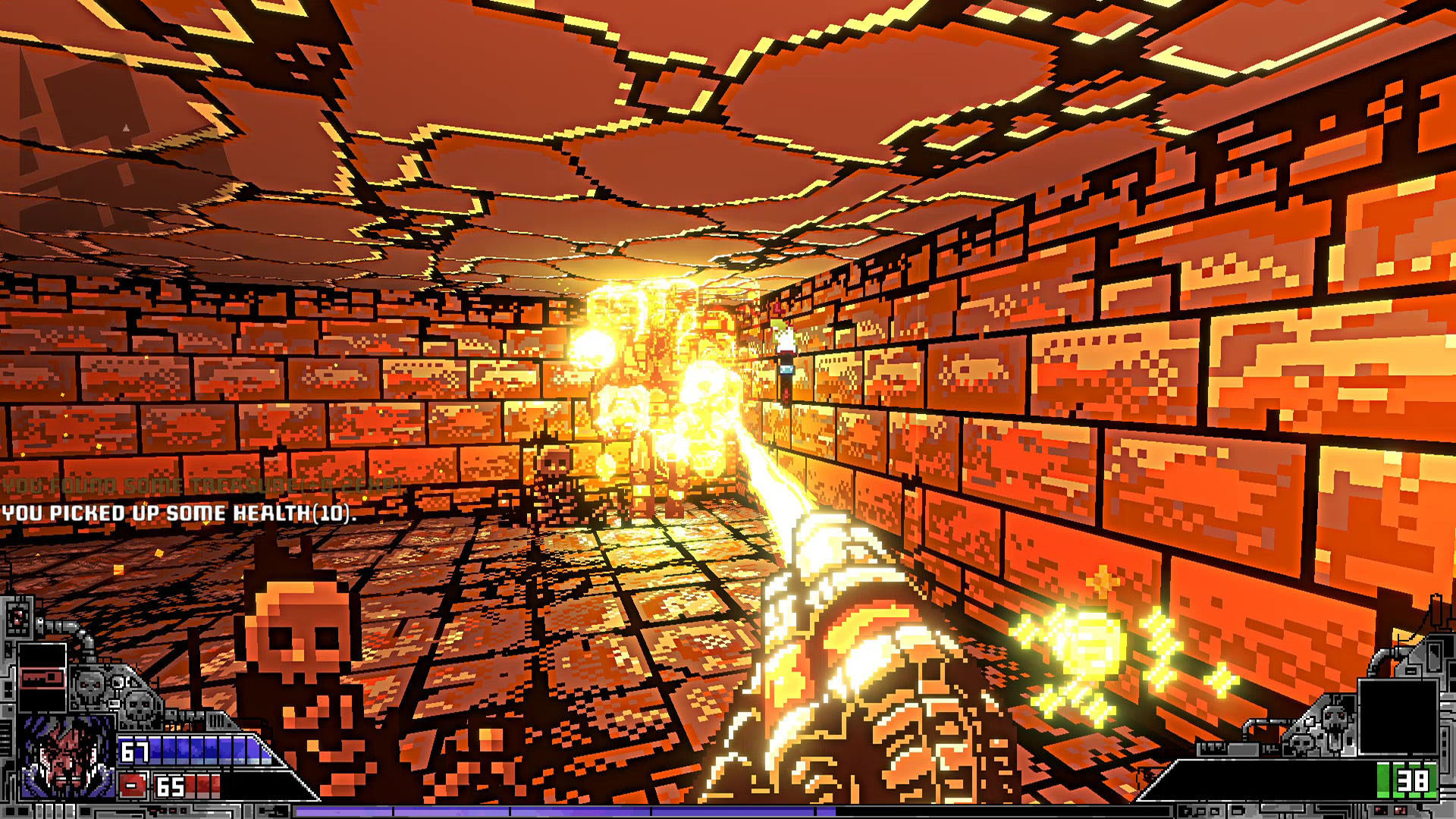One of the biggest joys I experience working in video game media has been randomly coming across gems that I’d have otherwise never known about.
Such is the case with Project Warlock, a retro-inspired first-person shooter originally started as a Kickstarter project by then high school student Jakub Cislo. (After various setbacks, Cislo finally found enough success with early builds of his project that he was able to assemble a small team to increase the game’s scope and quality.) Project Warlock is the type of game I could easily have missed, given all the other releases I’ve been reviewing lately, the flood of news coming out from our industry, and my growing apathy for “new game pretending like it’s an old game” projects.
What made me pay more attention this time was the game’s trailer. Project Warlock’s visuals hit you instantly with a style I’m not sure I’ve seen before in a game like this. While the game’s design resembles one of its biggest sources of inspiration, Doom—in other words, 2D sprite enemies set atop 3D polygon-based worlds—its sprite work really stands out. There’s a level of detail and artistic flair to the sprites here that you don’t usually see in similar shooters, with sprites that almost remind me of those back on the SNES or maybe even the NeoGeo. The art direction here could easily have gone wrong were it either too detailed or not detailed enough, but the end result sits in a very happy medium.

Thankfully, Project Warlock plays as good as it looks. As a shooter, it’s simple in a way that harks back to the earlier days of the genre, but it also has that depth of gameplay the best offerings from that era possessed. Even on its default difficulty, Project Warlock’s challenge can catch you off guard if you’re not ready for it, and each of its five worlds bring new enemy types with different attack abilities and tactics. While most of the game’s guns resemble weapons that have become commonplace in first-person shooters, almost all of them feel incredibly satisfying to shoot, especially once you start getting into the upgrades they offer (which we’ll get to shortly). Like all good shooters, there are a ton of secrets to find on each stage, some of which become especially important to your survival. Oh, and while you start off with full aiming movement on the right analog stick by default, turn on the “lock Y-axis” option so that it plays more like classic Doom—trust me.
I also have to give credit to the team for the work they put into Project Warlock’s maps. When I started my first playthrough and got to a point where I could preview the areas ahead, I worried things might quickly become a slog, as most of the five main worlds task you with completing 11 stages before facing off against their bosses. That seemed like a long time to be stuck in any one location with the same themes and enemies, but Project Warlock then twists the different locations in various ways. For example, in the game’s first world, Medieval, you start off in a prison area. From there, you escape through the sewers, make your way through the graveyards, and on to the castle, before facing off against the Sorcerer.
Each of those subareas feel incredibly different from the another, and that idea repeats throughout the game’s other four worlds. Credit is also due Cislo for the art team he brought on board (especially lead artist Dawid Konrad Korzekwa) as Project Warlock grew into a bigger project during its production. Even though all of these locations feel antiquated compared to modern-day shooters on a technical level, the artwork and themes used for creating those stages bring them to life to an impressive degree, keeping you eager to see what might come next. Even better, along with the aforementioned secrets, the maps themselves require exploration, problem solving, and yes, even the now-taboo b-word—backtracking.

The cherry on top is that, even with the map count coming in at nearly 60, every single one has its own unique music. While not every track is a banger (as one might say), musicians Jerry Lehr and Luke Wilson have put an incredible amount of work into creating the game’s metal-inspired soundtrack. It is a shame, though, that the music wasn’t written in a way that it could seamlessly loop when playing.
Project Warlock finds a few ways to stand out from those classic games it pays homage to, the first of which becomes apparent the moment you select “new game.” In every difficulty level except for Casual, you have a set amount of lives, and once you’ve lost all of those lives, it’s game over. Like, totally over. I hadn’t fully appreciated what I’d been told when starting my first playthrough, so when the Sorcerer ate through the 11 lives I’d earned by that point, I figured I’d just have to go back to a set point or something. But no—if you use up all of your lives in Project Warlock, no matter how far you’ve made it, you’ll have to start again from the beginning. Once I got into the swing of things, making it through the entirety of the game wasn’t that bad on Standard difficulty, especially as it’s easy to earn a nice buffer of lives throughout the game. Although things did get a bit hairy for me on my second playthrough, when I finally beat the end boss with only five lives remaining—in part because, moron that I am, it was only then that I realized I’d gone nearly the entire game without finding the sprint button. I was terrified of losing all of my progress right at the end, but that terror makes for an exciting experience.
The one area where Project Warlock feels decidedly modern is in its upgrades system. While playing, you’ll earn XP, which earns you levels, which in turn earns you points to spend on increasing one of your four stats: strength, life, spirit, and capacity. For every five levels you earn, you receive Perk Points used to gain one of 12 passive perks. However, you’ll also find Upgrade Points along the way, which can either upgrade any of the 12 basic weapons you’ve found throughout the game or grant access to the various spells you’ll pick up in each world.

I know that all sounds a little complicated—especially for a game so focused on taking us back to a simpler era of first-person shooters—but it all results in a system that offers an incredible amount of player customization without sacrificing actual gameplay simplicity. The gun upgrades are especially fun choices to explore, as each weapon can evolve in one—but only one—of two ways. For example, once you find the chaingun, you can either make it more powerful and faster to start up, or turn it into a placeable sentry gun. Every Upgrade Point you spend on weapons, however, means one less to use unlocking spells, and that was one of the few areas of Project Warlock that disappointed me. Honestly, most of the spells didn’t seem to offer me worthwhile new abilities over the vast selection of weapons I already had—but I’m sure there will be players out there who prefer to go the magic route, and who do find those spells satisfying.
A Change of Scenery
I can’t forget to mention the graphical options included in Project Warlock. While the menu can be overwhelming at first, it offers up an incredible amount of customization, from turning on a variety of CRT shaders (with suboptions for changing the scanline static, movement, and screen distortion), to the ability to pick from a number of retro color palettes (such as C64, Amstrad CPC, ZX-Spectrum, and even Game Boy), to choices for bloom and motion blur post-processing, to even a full selection of color sliders. While I’m guessing most players will never touch anything from the graphics menu, it’s a treasure trove of extra effort that adds a special touch to the game.
Really, the only thing that truly tainted my time with Project Warlock was a smattering of technical complaints, and I’m not sure if they’re inherent to the game or just problems that might show up with the Xbox One port. At times, certain world textures glitch, and for some reason, switching to the melee axe from another weapon causes it to lag on its first swing. Speaking of weapon switching, Project Warlock uses the shoulder buttons to switch between the nine main weapon categories, after which you use a second button to toggle between that category’s two slots if they exist. (So, for example, switch to the shotguns category, and you can then choose between a single-barreled model in the first slot, and a double-barreled one in the second.) When you switch between categories, you stay in whatever slot you were just on. The problem is that, sometimes, my favorite weapon from one category was in slot one, while my go-to choice from its following category may have been in slot two. I wish that the game remembered my slot positions per-category, so that I could quickly rotate through a selection of personal choices, not just everything from one row or another.

I also ran into a few bugs that affected the game on more than just a visual level. On one particular late-game stage, the door to a secret room caused my entire game to crash, and trying again after restarting had the same results. The problem was, I was losing a life every time that happened, so I had to just finally give up. And, again at least on Xbox One, I never got credit for a number of the Achievements I’d completed. According to the game, I only ever beat the fourth boss and no others. Not that I’m the type of person who usually cares about that stuff, but it still kinda sucks.
For as much as I love sitting down with a game I’ve been anticipating for months (or even years) and having it turn out to achieve or exceed my expectations, there’s just something extra special about finding pleasure from a title I didn’t even know existed a few weeks ago. Though I’m not sure it’ll win over younger players raised on more modern shooters, Project Warlock is a warm, comforting blanket for those of us who were around for the earlier days of the genre, and feels like a true labor of love in an industry that can leave us all feeling a little too cynical at times.
Update: It seems a patch may have gone out between the time that I would have earned the Achievements that I didn’t get credit for, and the time I finished writing this review. So, that may no longer be an issue.
|
★★★★★
Project Warlock is a first-person shooter created by a tiny indie team that punches way above its weight. While its reason for existence may initially seem to be for paying homage to its genre’s forefathers, Project Warlock quickly grows into a game all its own, providing an enthralling shooter experience all the way to the end. |
Developer Buckshot Software, Crunching Koalas Publisher Crunching Koalas ESRB M - Mature Release Date 06.12.2020 |
| Project Warlock is available on PlayStation 4, Xbox One, Nintendo Switch, PC. Primary version played was for Xbox One X. Product was provided by Crunching Koalas for the benefit of this coverage. EGM reviews on a scale of one to five stars. | |

Mollie got her start in games media via the crazy world of gaming fanzines, and now works at EGM with the goal of covering all of the weird Japanese and niche releases that nobody else on staff cares about. She’s active in the gaming community on a personal level, and an outspoken voice on topics such as equality in gaming, consumer rights, and good UI. Check her out on Bluesky and Mastodon.